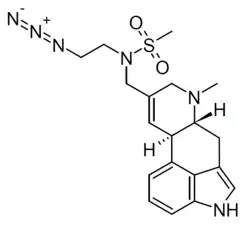GYKI-32887
 | |
| Clinical data | |
|---|---|
| Other names | GYKI32887; RGH-7825; RGH7825; 8-((N-2-Azidoethyl-N-methylsulfonylamino)methyl)-6-methylergol-8-ene |
| Drug class | Dopamine agonist; Antiparkinsonian agent |
| Identifiers | |
| |
| PubChem CID | |
| ChemSpider | |
| Chemical and physical data | |
| Formula | C19H24N6O2S |
| Molar mass | 400.50 g·mol−1 |
| 3D model (JSmol) | |
| |
| |
GYKI-32887, also known as RGH-7825, is a dopamine agonist and antiparkinsonian agent of the ergoline family which was never marketed.[1][2][3][4] It has a lysergamide-like structure but is not technically a lysergamide itself.[1] Similarly to other D2-like receptor agonists, direct injection of small doses of GYK-32887 into the nucleus accumbens decreases locomotor activity in rodents.[3] This effect can be blocked by D2-like receptor antagonists like haloperidol, fluphenazine, and sulpiride.[3] GYKI-32887 was first described in the scientific literature by 1983.[2][3][4]
See also
References
- ^ a b Negwer M (2001). Organic-chemical Drugs and Their Synonyms: An International Survey. Wiley-VCH. ISBN 978-3-527-30247-5. Retrieved 30 June 2025.
- ^ a b Borsy J, Király I, Magó-Karácsony E, Bagdy E, Berzétei I (1983). "Psychopharmacological Effects of a New Dopaminergic Agonist Compound GYK-32887". Acta Pharmaceutica Suecica: 190–194.
- ^ a b c d Király I, Van Ree JM (May 1984). "Non-opiate beta-endorphin fragments and dopamine--VI. Behavioural analysis of the interaction between gamma-type endorphins and dopaminergic systems in the nucleus accumbens of rats". Neuropharmacology. 23 (5): 511–516. doi:10.1016/0028-3908(84)90023-6. PMID 6204246.
- ^ a b Nógrádi M (1985). "RGH-7825". Drugs of the Future. 10 (9): 753. doi:10.1358/dof.1985.010.09.71741.